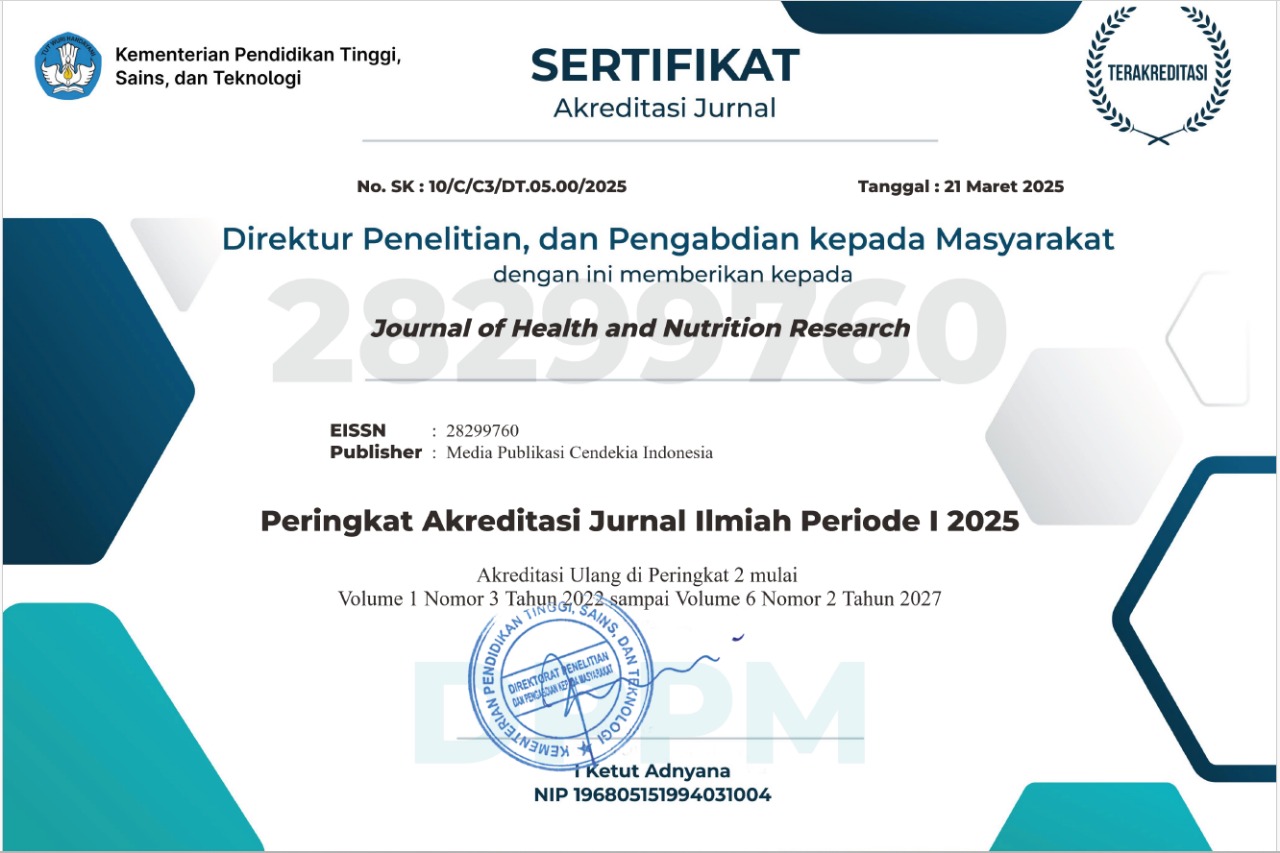Acute Oral Toxicity of Banggai Yam Flour Extract (Dioscorea alata) in Mice (Mus musculus)
Keywords:
Acute toxicity, Banggai yam, flour extract, miceAbstract
Banggai yam (Dioscorea alata), a local tuber cultivated in Central Sulawesi, Indonesia, is known for its rich nutritional content, including complex carbohydrates, dietary fiber, essential vitamins, minerals, and bioactive compounds such as anthocyanins and polyphenols. Although its nutritional potential has been well documented, its consumption safety, especially in processed forms such as powdered extract, requires toxicological validation. This study aimed to evaluate the acute oral toxicity of Banggai yam powdered extract using a murine model. This study had three treatment groups that received Banggai yam flour extract at different doses (1.95 g, 3.906 g, and 5.9 g) and one control group that received 1% CMC Na. Observations and measurements were analyzed using independent sample t-tests through SPSS software. The analysis did not show statistically significant differences between the treatment and control groups, with p-values of 0.55, 0.97, and 0.85, respectively. These findings indicate that Banggai yam extract does not produce acute toxic effects at the dose levels tested. In conclusion, in animal models, Banggai yam flour extract is considered non-toxic under acute exposure conditions. Further studies involving subchronic and chronic toxicity tests and evaluation in human subjects are recommended to confirm its broader safety profile and support its use as a functional food ingredient.
Downloads
References
Roche ML, Gyorkos TW, Blouin B, Marquis GS, Sarsoza J, Kuhnlein H V. Infant and young child feeding practices and stunting in two highland provinces in Ecuador. Maternal and Child Nutrition. 2017;
Dewey KG and AA. Systematic Review of the Efficacy and Effectiveness of Complementary Feeding Interventions in Developing Countries. Maternal & Child Nutrition, 4, 24-85. 2018;4:24-85.
Rahmatu, R Dg, Ramadanil, dan Sangaji MN. Inventarisasi dan identifikasi Tanaman Ubi Banggai di kepulauan Banggai Sulawesi Tengah. Proyek Penelitian ARMP-II, Kerjasama Universitas Tadulako dengan Balai Penelitian Tanaman Pangan, Palu:Universitas Tadulako. 2001.
If’all I, Hasanuddin A, Rahim A, Kadir S. Karakteristik Fisik, Kimia, dan Fungsional Pati Ubi Banggai Asetat pada Berbagai Variasi Waktu Reaksi. agriTECH. 2021;40(4).
Lee HR, Kong SY, Sung SH, Kim HJ. DA-9801 and its saponins, dioscin and protodioscin, protect primary cortical neurons from hyperglycemia-induced neurotoxicity. Journal of Functional Foods. 2019;54.
Oke MO, Awonorin SO, Workneh TS. Effect of varieties on physicochemical and pasting characteristics of water yam flours and starches. African Journal of Biotechnology. 2013;12(11):1250–6.
Patel K, Gadewar M, Tahilyani V, Patel DK. A review on pharmacological and analytical aspects of diosgenin: a concise report. Vol. 2, Natural Products and Bioprospecting. 2012.
Astawan M. Pangan Fungsional untuk Kesehatan yang Optimal. Vol. 53, Journal of Chemical Information and Modeling. 2011.
Radikasari Cindy, Ihwan R. Sub-Chronic Toxicity Of Purple Yam (Dioscorea Alata L.) Ethanol Extract In Serum Glutamat Oxaloacetic Transminase And Serum Glutamic Pyruvic Transminase Of White Rat (Rattus Novergicus) IN VIVO. Jurnal Ilmiah Medicamento. 5(1):27–32.
Izmat IA. Toksisitas Subkronik Ekstrak Etanol Ubi Banggai (Dioscorea Alata) dengan parameter Histopatologi pankreas Pada Tikus Putih (rattus norvegicus). Universitas Tadulako; 2020.
Society E. World Health Organization ( WHO ) guideline on the complementary feeding of infants and young children aged 6 − 23 months 2023 : A multisociety response. 2024;(May):1–8.
Hung NT, Hang LT, Phuong TTT, Anh NTD, Hien VTT, Thuy BT, et al. A Clinical Trial on the Glycemic Index of Nutritional Product for Diabetes Mellitus. Journal of Pharmaceutical Research International. 2021;(January 2024):222–30.
Owolabi AO, Oladipo EK, Adekunle AA. Phytochemical constituents and antioxidant potential of selected sweet potato (Ipomoea batatas) varieties. Journal of Functional Foods. 2021;78:104355.
Oboh G, Ademosun AO, Bello F. Antinutritional factors and bioavailability of micronutrients in selected local foods: A review. Current Research in Nutrition and Food Science Journal. 2023;11(1):1–15.
Hisamuddin ASB, Zaini AS, Abdullah N, Rahmat A. Phytochemical component and toxicological evaluation of purple sweet potato (Ipomoea batatas) leaf extract in male Sprague–Dawley rats. Frontiers in Pharmacology. 2023;14:1132087.
Khairani AF, Hanifa RA, Andriani A. Acute and sub-chronic oral toxicity study of purple sweet potato (Ipomoea batatas [L.] Lam) yogurt in mice (Mus musculus). Veterinary World. 2022;15(3):789–96.
Induar S, Dubey D, Rath S, Meher R, Swain S, Tripathy S. Evaluation of the Antioxidant and Antimicrobial Activity of the Nutritionally Rich Plant, Dioscorea alata L. Biomedical & Pharmacology Journal. 2024;17:1265–78.
N. Makiyah SN, Usman S, R. Dwijayanti D. In Silico Toxicity Prediction of Bioactive Compounds of Dioscorea alata L.: http://www.doi.org/10.26538/tjnpr/v6i10.5. Tropical Journal of Natural Product Research (TJNPR). 2022 Oct 1;6(10 SE-Articles):1587–96.
Oki T, Masuda M, Kobayashi M, Nishiba Y, Furuta S, Suda I. Polyphenol composition and antioxidant activity of sweet potato leaves. Food Chemistry. 2002;83(2):169–74.
Truong VD, McFeeters RF, Thompson RT, Dean LL, Shofran BG. Phenolic acid content and composition in leaves and roots of common commercial sweet potato (Ipomoea batatas L.) cultivars in the United States. Journal of Agricultural and Food Chemistry. 2018;55(4):1099–106.

Published
How to Cite
Issue
Section
Copyright (c) 2025 Marselina Sattu, Muh Syahrir, NHD Gunawan

This work is licensed under a Creative Commons Attribution-NonCommercial-ShareAlike 4.0 International License.
Most read articles by the same author(s)
- Fitrianty Sutadi Lanyumba, Gebby Pongsampe, Herawati Herawati, Maria Kanan, Marselina Sattu, Ramli Bidullah, Nur Hendra Dwi Gunawan, Assessing Patient Satisfaction in an Internal Medicine Polyclinic Using Cartesian Analysis: A Case Study at Luwuk Regional Hospital , Journal of Health and Nutrition Research: Vol. 4 No. 2 (2025)

















